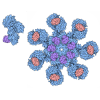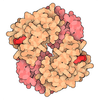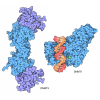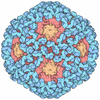+ Open data
Open data
- Basic information
Basic information
| Entry | Database: PDB / ID: 9dch | |||||||||
|---|---|---|---|---|---|---|---|---|---|---|
| Title | Single-stranded RNA-mediated PRC2 dimer | |||||||||
 Components Components |
| |||||||||
 Keywords Keywords | GENE REGULATION / PRC2 / RNA / RNP complex / chromatin modifier | |||||||||
| Function / homology |  Function and homology information Function and homology informationprotein localization to pericentric heterochromatin / hepatocyte homeostasis / cellular response to trichostatin A / regulation of gliogenesis / negative regulation of striated muscle cell differentiation / regulation of kidney development / [histone H3]-lysine27 N-trimethyltransferase / response to tetrachloromethane / CAF-1 complex / negative regulation of keratinocyte differentiation ...protein localization to pericentric heterochromatin / hepatocyte homeostasis / cellular response to trichostatin A / regulation of gliogenesis / negative regulation of striated muscle cell differentiation / regulation of kidney development / [histone H3]-lysine27 N-trimethyltransferase / response to tetrachloromethane / CAF-1 complex / negative regulation of keratinocyte differentiation / histone H3K27 trimethyltransferase activity / negative regulation of retinoic acid receptor signaling pathway / cerebellar cortex development / primary miRNA binding / random inactivation of X chromosome / regulation of adaxial/abaxial pattern formation / skeletal muscle satellite cell maintenance involved in skeletal muscle regeneration / regulatory ncRNA-mediated heterochromatin formation / negative regulation of cardiac muscle cell proliferation / histone H3K27 methyltransferase activity / sex chromatin / ubiquitin-modified histone reader activity / positive regulation of cell cycle G1/S phase transition / NURF complex / facultative heterochromatin formation / NuRD complex / regulation of cell fate specification / negative regulation of stem cell population maintenance / genomic imprinting / DNA replication-dependent chromatin assembly / Transcription of E2F targets under negative control by p107 (RBL1) and p130 (RBL2) in complex with HDAC1 / ESC/E(Z) complex / negative regulation of stem cell differentiation / regulation of stem cell differentiation / RSC-type complex / protein-lysine N-methyltransferase activity / Polo-like kinase mediated events / cardiac muscle hypertrophy in response to stress / chromatin silencing complex / histone H3K9me2/3 reader activity / Transcription of E2F targets under negative control by DREAM complex / pronucleus / positive regulation of dendrite development / G1 to G0 transition / histone H3 methyltransferase activity / histone methyltransferase activity / DNA methylation-dependent constitutive heterochromatin formation / negative regulation of G1/S transition of mitotic cell cycle / spinal cord development / ATPase complex / lncRNA binding / negative regulation of gene expression, epigenetic / synaptic transmission, GABAergic / G1/S-Specific Transcription / Sin3-type complex / Transcriptional Regulation by E2F6 / : / positive regulation of stem cell population maintenance / positive regulation of MAP kinase activity / histone methyltransferase complex / oligodendrocyte differentiation / RNA Polymerase I Transcription Initiation / histone deacetylase complex / negative regulation of transcription elongation by RNA polymerase II / G0 and Early G1 / positive regulation of GTPase activity / positive regulation of protein serine/threonine kinase activity / negative regulation of cell differentiation / cardiac muscle cell proliferation / positive regulation of epithelial to mesenchymal transition / ribonucleoprotein complex binding / subtelomeric heterochromatin formation / pericentric heterochromatin / RNA polymerase II core promoter sequence-specific DNA binding / Cyclin E associated events during G1/S transition / Transcriptional regulation of brown and beige adipocyte differentiation by EBF2 / Cyclin A:Cdk2-associated events at S phase entry / nucleosome binding / keratinocyte differentiation / spleen development / Regulation of TP53 Activity through Acetylation / protein localization to chromatin / liver regeneration / negative regulation of cytokine production involved in inflammatory response / Deposition of new CENPA-containing nucleosomes at the centromere / negative regulation of cell migration / SUMOylation of chromatin organization proteins / thymus development / cellular response to leukemia inhibitory factor / central nervous system development / B cell differentiation / ubiquitin binding / Regulation of PTEN gene transcription / transcription corepressor binding / ERCC6 (CSB) and EHMT2 (G9a) positively regulate rRNA expression / PRC2 methylates histones and DNA / Regulation of endogenous retroelements by KRAB-ZFP proteins / Defective pyroptosis / transcription coregulator activity / hippocampus development Similarity search - Function | |||||||||
| Biological species |  Homo sapiens (human) Homo sapiens (human) | |||||||||
| Method | ELECTRON MICROSCOPY / single particle reconstruction / cryo EM / Resolution: 3.4 Å | |||||||||
 Authors Authors | Song, J.S. / Kasinath, V.K. | |||||||||
| Funding support |  United States, 2items United States, 2items
| |||||||||
 Citation Citation |  Journal: bioRxiv / Year: 2025 Journal: bioRxiv / Year: 2025Title: RNA-induced PRC2 inhibition depends on the sequence of bound RNA. Authors: Jiarui Song / Liqi Yao / Anne R Gooding / Valentin Thron / Wayne O Hemphill / Karen Goodrich / Vignesh Kasinath / Thomas R Cech Abstract: Methyltransferase PRC2 (Polycomb Repressive Complex 2) deposits histone H3K27 trimethylation to establish and maintain epigenetic gene silencing. PRC2 is precisely regulated by accessory proteins, ...Methyltransferase PRC2 (Polycomb Repressive Complex 2) deposits histone H3K27 trimethylation to establish and maintain epigenetic gene silencing. PRC2 is precisely regulated by accessory proteins, histone post-translational modifications and, particularly, RNA. Research on PRC2-associated RNA has mostly focused on the tight-binding G-quadruplex (G4) RNAs, which inhibit PRC2 enzymatic activity in vitro and in cells, a mechanism explained by our recent cryo-EM structure showing G4 RNA-mediated PRC2 dimerization. However, PRC2 binds a wide variety of RNA sequences, and it remains unclear how diverse RNAs beyond G4 associate with and regulate PRC2. Here, we show that variations in RNA sequence elicit distinct effects on PRC2 function. A single-stranded G-rich RNA and an atypical G4 structure called a pUG-fold mediate PRC2 dimerization nearly identical to that induced by G4 RNA. In contrast, pyrimidine-rich RNAs, including a motif identified by CLIPseq in cells, do not induce PRC2 dimerization and instead bind PRC2 monomers with retention of methyltransferase activity. Only RNAs that dimerize PRC2 compete with nucleosome binding and inhibit PRC2 methyltransferase activity. CRISPR-dCas9 was adapted to localize different RNA elements onto a PRC2-targeted gene, revealing RNA sequence specificity for PRC2 regulation in cells. Thus, PRC2 binds many different RNAs with similar affinity, however, the functional effect on enzymatic activity depends entirely on the sequence of the bound RNA, a conclusion potentially applicable to any RNA- binding protein with a large transcriptome. | |||||||||
| History |
|
- Structure visualization
Structure visualization
| Structure viewer | Molecule:  Molmil Molmil Jmol/JSmol Jmol/JSmol |
|---|
- Downloads & links
Downloads & links
- Download
Download
| PDBx/mmCIF format |  9dch.cif.gz 9dch.cif.gz | 641.7 KB | Display |  PDBx/mmCIF format PDBx/mmCIF format |
|---|---|---|---|---|
| PDB format |  pdb9dch.ent.gz pdb9dch.ent.gz | 467.8 KB | Display |  PDB format PDB format |
| PDBx/mmJSON format |  9dch.json.gz 9dch.json.gz | Tree view |  PDBx/mmJSON format PDBx/mmJSON format | |
| Others |  Other downloads Other downloads |
-Validation report
| Summary document |  9dch_validation.pdf.gz 9dch_validation.pdf.gz | 1.4 MB | Display |  wwPDB validaton report wwPDB validaton report |
|---|---|---|---|---|
| Full document |  9dch_full_validation.pdf.gz 9dch_full_validation.pdf.gz | 1.4 MB | Display | |
| Data in XML |  9dch_validation.xml.gz 9dch_validation.xml.gz | 101.5 KB | Display | |
| Data in CIF |  9dch_validation.cif.gz 9dch_validation.cif.gz | 158.5 KB | Display | |
| Arichive directory |  https://data.pdbj.org/pub/pdb/validation_reports/dc/9dch https://data.pdbj.org/pub/pdb/validation_reports/dc/9dch ftp://data.pdbj.org/pub/pdb/validation_reports/dc/9dch ftp://data.pdbj.org/pub/pdb/validation_reports/dc/9dch | HTTPS FTP |
-Related structure data
| Related structure data |  46751MC C: citing same article ( M: map data used to model this data |
|---|---|
| Similar structure data | Similarity search - Function & homology  F&H Search F&H Search |
- Links
Links
- Assembly
Assembly
| Deposited unit | 
|
|---|---|
| 1 |
|
- Components
Components
-Protein , 4 types, 8 molecules AHDKFMEL
| #2: Protein | Mass: 86017.859 Da / Num. of mol.: 2 Source method: isolated from a genetically manipulated source Source: (gene. exp.)  Homo sapiens (human) / Gene: EZH2, KMT6 / Production host: Homo sapiens (human) / Gene: EZH2, KMT6 / Production host:  Trichoplusia ni (cabbage looper) Trichoplusia ni (cabbage looper)References: UniProt: Q15910, [histone H3]-lysine27 N-trimethyltransferase #4: Protein | Mass: 47709.527 Da / Num. of mol.: 2 Source method: isolated from a genetically manipulated source Source: (gene. exp.)  Homo sapiens (human) / Gene: RBBP4, RBAP48 / Production host: Homo sapiens (human) / Gene: RBBP4, RBAP48 / Production host:  Trichoplusia ni (cabbage looper) / References: UniProt: Q09028 Trichoplusia ni (cabbage looper) / References: UniProt: Q09028#5: Protein | Mass: 32881.473 Da / Num. of mol.: 2 Source method: isolated from a genetically manipulated source Source: (gene. exp.)  Homo sapiens (human) / Gene: AEBP2 / Production host: Homo sapiens (human) / Gene: AEBP2 / Production host:  Trichoplusia ni (cabbage looper) / References: UniProt: Q6ZN18 Trichoplusia ni (cabbage looper) / References: UniProt: Q6ZN18#6: Protein | Mass: 36021.391 Da / Num. of mol.: 2 Source method: isolated from a genetically manipulated source Source: (gene. exp.)  Homo sapiens (human) / Gene: JARID2, JMJ / Production host: Homo sapiens (human) / Gene: JARID2, JMJ / Production host:  Trichoplusia ni (cabbage looper) / References: UniProt: Q92833 Trichoplusia ni (cabbage looper) / References: UniProt: Q92833 |
|---|
-Polycomb protein ... , 2 types, 4 molecules BICJ
| #3: Protein | Mass: 82353.133 Da / Num. of mol.: 2 Source method: isolated from a genetically manipulated source Source: (gene. exp.)  Homo sapiens (human) / Gene: SUZ12, CHET9, JJAZ1, KIAA0160 / Production host: Homo sapiens (human) / Gene: SUZ12, CHET9, JJAZ1, KIAA0160 / Production host:  Trichoplusia ni (cabbage looper) / References: UniProt: Q15022 Trichoplusia ni (cabbage looper) / References: UniProt: Q15022#7: Protein | Mass: 50267.691 Da / Num. of mol.: 2 Source method: isolated from a genetically manipulated source Source: (gene. exp.)  Homo sapiens (human) / Gene: EED / Production host: Homo sapiens (human) / Gene: EED / Production host:  Trichoplusia ni (cabbage looper) / References: UniProt: O75530 Trichoplusia ni (cabbage looper) / References: UniProt: O75530 |
|---|
-RNA chain / Non-polymers , 2 types, 15 molecules G

| #1: RNA chain | Mass: 3257.980 Da / Num. of mol.: 1 / Source method: obtained synthetically / Source: (synth.)  Homo sapiens (human) Homo sapiens (human) |
|---|---|
| #8: Chemical | ChemComp-ZN / |
-Details
| Has ligand of interest | N |
|---|---|
| Has protein modification | Y |
-Experimental details
-Experiment
| Experiment | Method: ELECTRON MICROSCOPY |
|---|---|
| EM experiment | Aggregation state: PARTICLE / 3D reconstruction method: single particle reconstruction |
- Sample preparation
Sample preparation
| Component |
| ||||||||||||||||||||||||
|---|---|---|---|---|---|---|---|---|---|---|---|---|---|---|---|---|---|---|---|---|---|---|---|---|---|
| Source (natural) |
| ||||||||||||||||||||||||
| Source (recombinant) | Organism:  Trichoplusia ni (cabbage looper) / Strain: BTI-Tn-5B1-4 Trichoplusia ni (cabbage looper) / Strain: BTI-Tn-5B1-4 | ||||||||||||||||||||||||
| Buffer solution | pH: 7.9 Details: RNP complex buffer (25 mM HEPES pH 7.9, 50 mM KCl, 2 mM MgCl2, 10% glycerol, and 1 mM TCEP) EM preparation buffer I (25 mM HEPES pH 7.9, 50 mM KCl, 2.5% glycerol, and 1 mM TCEP) EM ...Details: RNP complex buffer (25 mM HEPES pH 7.9, 50 mM KCl, 2 mM MgCl2, 10% glycerol, and 1 mM TCEP) EM preparation buffer I (25 mM HEPES pH 7.9, 50 mM KCl, 2.5% glycerol, and 1 mM TCEP) EM preparation buffer II (25 mM HEPES pH 7.9, 50 mM KCl, 2.5% glycerol, 0.01%NP-40, and 1 mM TCEP). | ||||||||||||||||||||||||
| Specimen | Embedding applied: NO / Shadowing applied: NO / Staining applied: NO / Vitrification applied: YES Details: We used streptavidin-affinity grid preparation method with biotin-labeled RNA at 100 nM concentration. PRC2 was applied in excess at 600 nM. | ||||||||||||||||||||||||
| Vitrification | Instrument: LEICA EM GP / Cryogen name: ETHANE / Humidity: 90 % / Chamber temperature: 281 K / Details: 2-3s of single side blotting |
- Electron microscopy imaging
Electron microscopy imaging
| Experimental equipment |  Model: Titan Krios / Image courtesy: FEI Company |
|---|---|
| Microscopy | Model: FEI TITAN KRIOS |
| Electron gun | Electron source:  FIELD EMISSION GUN / Accelerating voltage: 300 kV / Illumination mode: FLOOD BEAM FIELD EMISSION GUN / Accelerating voltage: 300 kV / Illumination mode: FLOOD BEAM |
| Electron lens | Mode: BRIGHT FIELD / Calibrated magnification: 130000 X / Nominal defocus max: 1900 nm / Nominal defocus min: 500 nm / Cs: 2.7 mm |
| Specimen holder | Cryogen: NITROGEN / Specimen holder model: FEI TITAN KRIOS AUTOGRID HOLDER |
| Image recording | Electron dose: 50 e/Å2 / Film or detector model: FEI FALCON IV (4k x 4k) / Num. of grids imaged: 2 / Num. of real images: 14230 Details: Cryo-EM data was collected using a Titan Krios G3i equipped with a Thermo Fisher Falcon 4 direct-electron detector (DED) camera and a Selectris energy filter set with a 10-eV slit width. ...Details: Cryo-EM data was collected using a Titan Krios G3i equipped with a Thermo Fisher Falcon 4 direct-electron detector (DED) camera and a Selectris energy filter set with a 10-eV slit width. Data acquisition was performed using Thermo Fisher EPU at 130,000x magnification (0.97 A/pixel) with a defocus range of minus 1.9 to minus 0.5 micrometer. Movies were collected in EER format with a total dose of 50 electrons per square angstrom and an exposure time of 5.49 s corresponding to 1323 frames. |
| EM imaging optics | Energyfilter name: TFS Selectris X / Energyfilter slit width: 10 eV |
- Processing
Processing
| EM software |
| ||||||||||||||||||||||||||||||||||||||||
|---|---|---|---|---|---|---|---|---|---|---|---|---|---|---|---|---|---|---|---|---|---|---|---|---|---|---|---|---|---|---|---|---|---|---|---|---|---|---|---|---|---|
| Image processing | Details: Gain correction was applied during motion correction using Relion own implementation of the UCSF motioncor2 program | ||||||||||||||||||||||||||||||||||||||||
| CTF correction | Details: CTFind / Type: PHASE FLIPPING AND AMPLITUDE CORRECTION | ||||||||||||||||||||||||||||||||||||||||
| Particle selection | Num. of particles selected: 3385491 / Details: TOPAZ auto picking | ||||||||||||||||||||||||||||||||||||||||
| 3D reconstruction | Resolution: 3.4 Å / Resolution method: FSC 0.143 CUT-OFF / Num. of particles: 120658 / Symmetry type: POINT | ||||||||||||||||||||||||||||||||||||||||
| Atomic model building | Details: Individual PRC2 protomers were built using cryo-EM maps from the multibody refinement. The coordinates of G-quadruplex RNA-bound PRC2 six-subunit complex (PDB: 8FYH) provided a starting ...Details: Individual PRC2 protomers were built using cryo-EM maps from the multibody refinement. The coordinates of G-quadruplex RNA-bound PRC2 six-subunit complex (PDB: 8FYH) provided a starting model from which all the coordinates were adjusted and rebuilt in the new map using COOT. The model of each PRC2 promoter was subjected to global refinement and minimization in real space using PHENIX. These were then subjected to manual inspection and adjustment in COOT, followed by refinement again in PHENIX. TERRAmut RNA model was generated using a 10-nucleotide single-stranded fragment (UGAGUGUGAG) using AlphaFold3 and then docked into our map for the position we designated as the RNA density. | ||||||||||||||||||||||||||||||||||||||||
| Atomic model building | PDB-ID: 8FYH Accession code: 8FYH / Source name: PDB / Type: experimental model |
 Movie
Movie Controller
Controller





 PDBj
PDBj





















